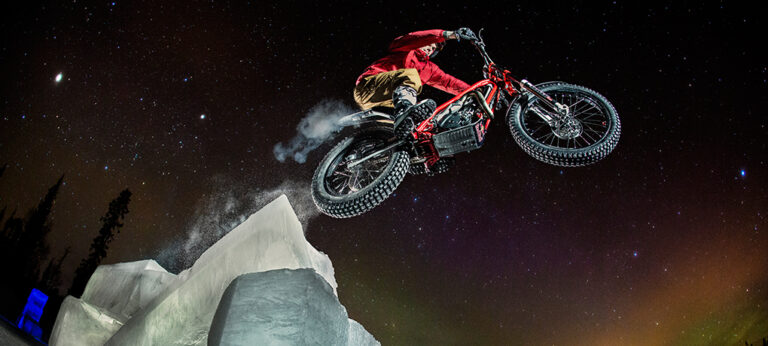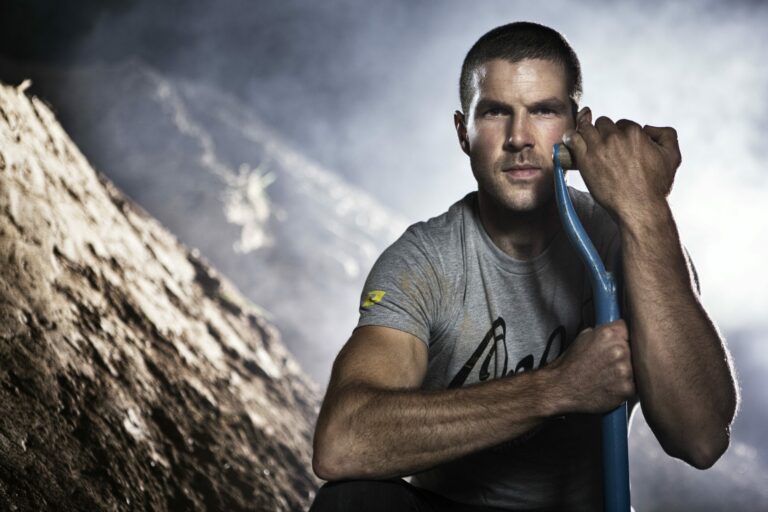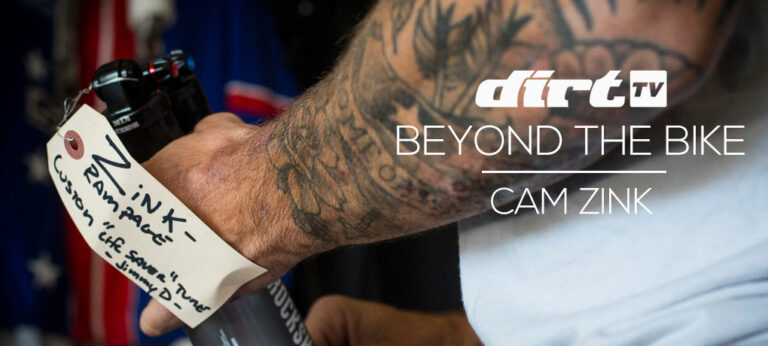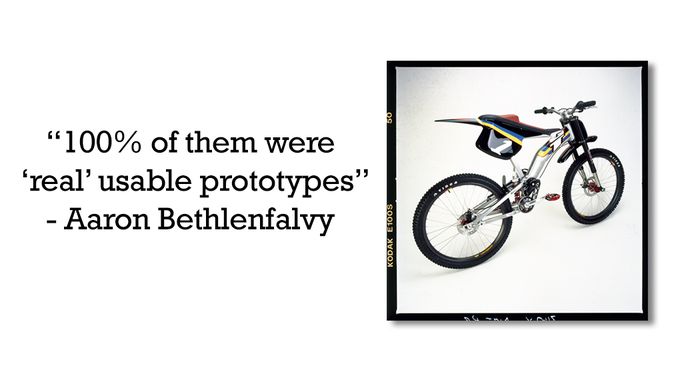
BLAST FROM THE PAST GT CONCEPT BIKE 1997
Words: by Mike Rose
Photo: Simon Cudby/GT
I have had a medium–format slide stuck on the wall next to my desk for years now. It’s a studio shot of a bike (yeah, the one shown here), but it is no ordinary bike. It is not of this time – even now it has a kind of space age look to it. It looks modern and futuristic, but it also has a definite retro feel. Kind of old but new (or new but old). I had never really questioned what this bike was all about… until now that is. It is clearly a GT, but I needed to find out more.
The first email I fired off was to Todd Seplavy, GT’s Director of Product based out in their Wilton (Connecticut) office. I explained the story and sent him through a rough copy of the slide so he would have an idea of what I was going on about. Now Todd knows a lot about bikes, but I wasn’t expecting him to come out with, “you mean the bike that is hanging up on the wall behind me”! It was right there, and of course Todd knew exactly who I needed to get in touch with; Aaron Bethlenfalvy was GT’s former Head of Design and was more than happy to answer some questions.
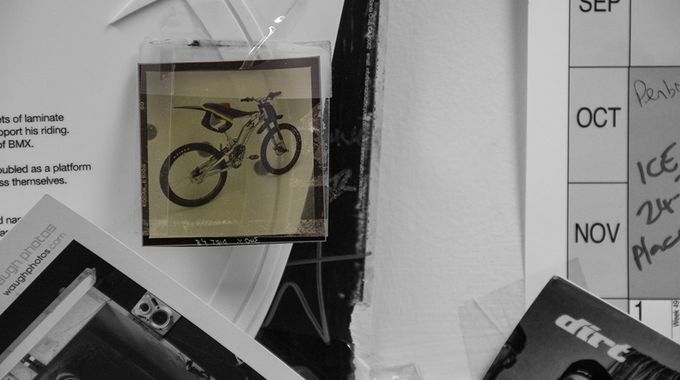
Dirt: I’m not sure who took the shot but the bike is definitely a GT, what can you tell us about it?
Aaron: I think Simon Cudby took the photo, he was our in–house staff photographer at the time we made this concept bike. The bike came into existence when GT’s Sr. Suspension Engineer, Jim Busby, developed a planetary gearbox suspension design in 1996. Throughout ‘96 Jim created a number of prototypes from which he perfected the system which utilised a modified Shimano Nexus 7–speed hub. Once Jim had the system working well the company wanted to unveil it to the public, so I was asked to build a concept bike that showcased the technology. This was a commonly used methodology at GT back in the day. It was our way of exploring concepts, gauging consumer interest, getting free press and to be constantly innovating.
Did this bike have a name, and was it ever actually ridden or raced? I guess it never made it into production.
We did not have a name for the bike other than ‘The Concept gearbox bike’. More of an internal reference than a name. The bike was ridden, although not aggressively or in a race setting, by a few R&D people and Hans Rey. Unfortunately it never made it into production. When the product development team approached Shimano about the hub/gearbox with the desire to either purchase the modified hub or purchase the hub to modify, Shimano refused. They must have felt that the application exceeded the hub’s intended usage which would expose them to warranty issues (just a guess). Needless to say, the GT gearbox concept slipped into the shadows as a result.
How many concept bikes were you involved with during that time at GT, and how many of them made it from the drawing board into actual ‘real’ useable prototypes?
Over the course of my tenure at GT I was involved with the creation of over 15 concept bikes. Of those, 100% of them were ‘real’ usable prototypes. I inherited a philosophy from my first boss, GT’s Industrial Design Director Jeff Soucek. “Anybody can make something look cool. What separates us from them is our ability to make it work.” I took this to heart and to this day refuse to waiver on the philosophy. I would estimate that only one or two of the concept bikes made it into production virtually unchanged. Two where completely conceptual and made just for fun with no intent of production. Of the remaining concept pieces, small details on each where refined and added to production models.
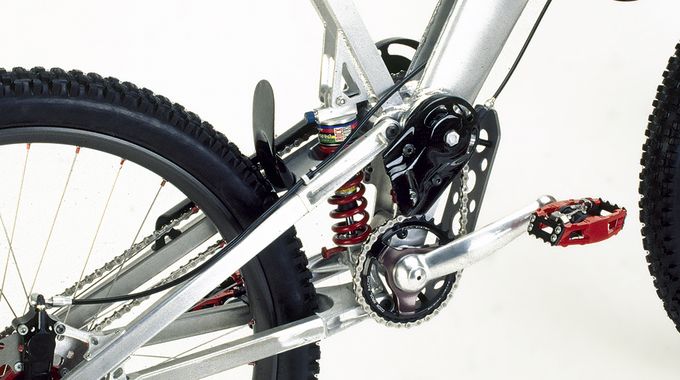
It is obviously very moto inspired, was there a reason for this?
Yes, it was very moto inspired! Speaking with our athletes at the time, they expressed an interest in exploring some concepts from the moto space which could aid them in World Cup races. Namely, front and rear fenders to limit the amount of mud in their face, an extended saddle with padding to prevent banging their knees–up while cornering and to offer a larger fore to aft seating area, number plates and bash guard to protect the front ring. The front fender concept led to the creation of prototype front fenders that our team used throughout the 1997–98 season and later led to entire companies that specialise in them. DH saddles saw an increase in size in the years to follow as well.
You were GT’s Head of Design back then, were you just designing bikes, or was it graphics, adverts, etc.?
I started working for GT in 1995 at the Santa Ana, CA, facility as an industrial designer developing frames, forks and every component you could imagine. I became their Industrial Design Director in 1999 with three people working under me and held that position until I left the company in 2001. I returned in 2006 as Pacific Cycles Industrial Design Director working from the Lake Forrest, CA, office and was transferred to Bethel, CT, headquarters to be Cycling Sports Group’s Global VP of Design in 2009. At that time I had a team of 20 people and responsibilities grew from industrial design to include graphic design and collateral development as well. All things ‘design’ for all of CSG’s (which includes GT) brands where coming from my team.
How did you originally end up working for GT, how did it come about?
While I was a student at the Ohio State University studying Industrial Design, I had the opportunity to select my own project for my senior thesis. I choose to design a police patrol mountain bike in the hope that it would land me a position within the bike industry. I proceeded to get ‘sponsors’ for the project, amongst them was GT, a brand whose bikes I had owned for the better part of my life. Upon completion of the project I gave it all to GT (research, development sketches, final designs, etc.) and they offered me a job. The police patrol bike that I developed was then shown at Interbike 1995. What’s left of the prototype sits in my garage today!
What are you doing now?
Today I am a partner with GSD Global, a product design and engineering consultancy specialising in the bicycle industry. We offer clients a broad range of development services including conceptual development, mechanical, structural, electrical and production engineering, kinematic and CFD analysis, product management, graphic development and collateral development.
The bike now sits in GT’s office in Connecticut, are there any other ‘special’ bikes of yours there?
I’m unsure what else they still have in their possession. The company traded owners and moved locations numerous times and with each move their historical items like concept bikes slowly disappeared.
So there is a slice of downhill history you might have missed from the mag. There have definitely been a few interesting bikes and bits over the years, the Millyard was one of them and Alan Millyard recently developed a fork damper to go with the amazing rear shock. Check that out here
If you are looking for a few things that maybe should never have made it into production then the 15 Worst Bike Products Ever should keep you entertained!


